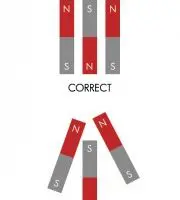You’ve asked, so we’re answering: Magnetic domains locked in, result in the ability of a permanent magnet to support an external magnetic field. Once established these domain positions are held until acted upon by forces exceeding those of the locked domains. The energy required to change the magnetic field produced by a magnet varies for each type of material. The following factors affect the strength and stability of permanent magnets and are causes of demagnetization.
TIME
The effect of time on today’s permanent magnet materials is minimal. Typically losses are less than 3% over the useful life of the magnet.
TEMPERATURE
Changes due to temperature effects fall into 3 categories
- Reversible losses
- Irreversible losses
- Metallurgical change
REVERSIBLE LOSSES…
are losses which are recovered when the magnet returns to its original temperature. Reversible temperature coefficients, expressed as % per degree, have been established for each material. They vary widely for various classes of material.
IRREVERSIBLE LOSSES…
are losses due to exposure to high or low temperatures. These losses take place when the operating point of the magnet falls below the knee of the material demagnetization curve. This type of loss can be recovered by re-magnetization.
METALLURGICAL CHANGES…
occur as permanent magnets are exposed to high temperatures. For all practical purposes, metallurgical changes render the magnet useless. Manufacturers have established “Maximum Use Temperatures” for each grade of material.
RELUCTANCE CHANGES
These changes occur when the operating slope of the magnet changes. Removal of a magnetized magnet from its circuit and replacement may cause the magnet’s operating slope to fall. Altering dimensions of the magnet circuit during use may cause reluctance changes. The magnitude of the loss is related to the material characteristics and the degree of the reluctance change.
ADVERSE FIELDS
Exposing magnetized magnets to opposing external fields produces a demagnetizing effect. This effect is most apparent in permanent magnet materials having a non-linear demagnetization curve, such as Alnico. These adverse fields may be produced by current carrying conductors or by allowing magnets to come into contact with other magnets or ferrous material. The degree of the loss depends on the material characteristics. Other factors such as SHOCK and VIBRATION have very little effect on today’s permanent magnet materials. Unfortunately, most of today’s materials are brittle and crack prone, and must be handled carefully to avoid damaging the magnets. RADIATION. Particularly at high levels, does result in flux changes which must be addressed in the design stage.
Questions? Contact us to learn more!
